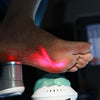Laser Therapy for Chronic Foot and Ankle Pain

Chronic foot and ankle pain can be crippling, impairing one's quality of life and mobility. This type of pain can be caused by a variety of conditions, including arthritis, plantar fasciitis, neuropathy, and injuries. Traditional treatments may not always provide effective relief, prompting many people to seek alternative solutions. Laser therapy, specifically low-level laser therapy (LLLT), has emerged as a promising treatment option for chronic foot and ankle pain. In this article, we will look at the science behind laser therapy, its benefits, and its use in treating chronic foot and ankle pain.
Understanding Laser Therapy
Photobiomodulation, also known as low-level laser therapy, is the use of specific wavelengths of light to stimulate cellular activity and promote healing. This non-invasive method is believed to be safe and has gained popularity in a variety of medical fields, including pain management.
The Science Behind It
Photobiomodulation is the basis for low-level laser therapy. When specific wavelengths of laser light penetrate the skin, they interact with the mitochondria, the energy-producing organelles within our cells. This interaction causes a cascade of biological responses, including increased ATP (adenosine triphosphate) production and nitric oxide release. These processes result in better cellular function, less inflammation, and faster tissue repair.
Laser Therapy Advantages for Foot and Ankle Pain
Laser therapy has been shown to reduce pain by decreasing inflammation and regulating nerve activity. This is especially beneficial for people suffering from chronic pain-causing conditions such as neuropathy, arthritis, or plantar fasciitis.
Enhanced Healing: Laser therapy promotes tissue repair and regeneration, which can speed up the healing process for foot and ankle injuries, sprains, and other musculoskeletal issues.
Non-Invasive: Laser therapy is a non-invasive treatment option, as opposed to surgery or injections. Patients can avoid the risks and time required for recovery associated with surgical procedures.
Side Effects: Laser therapy is generally well-tolerated, with few side effects. Some patients may feel tingling or mild warmth at the treatment site.
Improved Range of Motion: Laser therapy can help people with foot and ankle pain who are limited in their mobility by reducing pain and inflammation.
Laser Therapy Applications for Foot and Ankle Pain
Plantar Fasciitis: A common cause of heel pain is plantar fasciitis. Laser therapy can target inflamed tissue and promote healing, giving patients relief.
Neuropathy: Numbness, tingling, and pain in the feet and ankles are symptoms of peripheral neuropathy. By promoting nerve regeneration, laser therapy can help manage these symptoms.
Arthritis: Laser therapy can be used in conjunction with other treatments to reduce
inflammation and pain associated with osteoarthritis and rheumatoid arthritis.
Sports Injuries: Foot and ankle injuries are common among athletes. Laser therapy may speed up the healing process and allow them to return to their sport sooner.
Laser therapy can be used after surgery to reduce pain and inflammation, assisting in the healing process and improving overall recovery outcomes.
Considerations and Patient Experience
Patients should consult with a qualified healthcare provider who specializes in laser therapy before undergoing laser therapy for chronic foot and ankle pain. Depending on the condition being treated, the number of sessions required and the specific laser parameters may differ.
Patients typically feel a mild, warm sensation at the treatment site during a laser therapy session. The length of each session varies, but it is usually relatively short, lasting 15 to 30 minutes. Many patients report immediate relief or pain reduction after only a few sessions. A comprehensive treatment plan, on the other hand, may necessitate several sessions spread out over a few weeks.
Chronic foot and ankle pain can have a significant impact on a person's daily life. While traditional treatments have their place, laser therapy is a promising alternative for those in need of immediate relief. Laser therapy can stimulate cellular activity, reduce inflammation, and promote healing by harnessing the power of specific wavelengths of light. As research in this field advances, laser therapy is likely to become a more valuable tool in the comprehensive management of chronic foot and ankle pain, giving hope and comfort to countless people suffering from these conditions.





